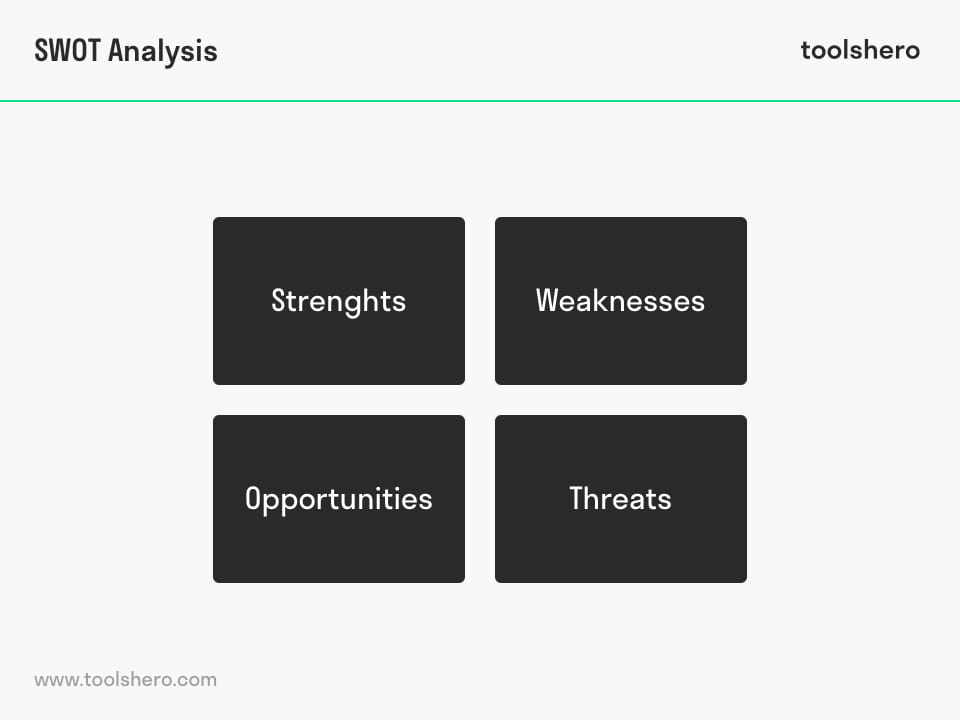SWOT Analysis explained

Imagine having a strategic planning tool that helps your business identify its strengths, weaknesses, opportunities, and threats, enabling you to make informed decisions and develop effective strategies. That’s exactly what SWOT analysis does, and businesses worldwide have been benefiting from it for years. In this article, you’ll learn how to conduct a SWOT analysis, explore real-life examples, and even access a free template to kick-start your strategic planning journey.
Short Summary
- SWOT Analysis provides comprehensive insight into an organization’s current state for crafting effective strategies.
- It examines internal and external factors, such as strengths, weaknesses, opportunities and threats.
- A step-by-step guide is provided to help create a tailored SWOT analysis with real examples and a free template.
Understanding the SWOT Framework
The first fundamentals of the SWOT Analysis was developed by Edmund P. Learned et al. (1969). This method was further developed by Albert Humphrey in the 1970s, and was based on the research of data from the Fortune 500 companies in the United States. In order to create a SWOT Analysis, users must ask and get answers, to generate meaningful information to fill in the main four elements.
SWOT, an acronym for Strengths, Weaknesses, Opportunities, and Threats, is a strategic planning tool that helps businesses assess their current state and pinpoint areas for development and expansion. It’s applicable to organizations of all sizes, from small businesses to large enterprises.
A SWOT analysis matrix, or SWOT matrix, provides a visual representation of these four perspectives, making it easier to identify and analyze the internal and external factors affecting the organization. In this context, SWOT stands for the assessment of strengths, weaknesses, opportunities, and threats.
The importance of swot analyses lies in its ability to assess assumptions, identify blind spots, and provide insight into the current state of the business, ultimately helping to craft the most suitable strategy for any given situation in practice or a business plan.
This is why swot analysis is important, as this comprehensive approach allows businesses to focus on leveraging their strengths, strengthening their weaker areas, warding off potential threats, and capitalizing on any potential opportunities. It is a great starting point for an organizational analysis.
Importance of SWOT Analysis
Conducting this type of analysis is crucial for businesses to gain insights into their current situation, identify areas for improvement, and capitalize on opportunities. By examining internal factors such as strengths and weaknesses, as well as external factors like opportunities and threats, businesses can develop a better understanding of their competitive advantages and areas requiring attention.
Real-life examples of SWOT analysis include Apple, which has leveraged its strong brand recognition to gain a competitive advantage, and Walmart, which has utilized its expansive distribution network to capitalize on potential opportunities. These examples demonstrate the value of SWOT analysis in helping businesses identify and exploit their unique strengths to stay ahead in the competitive landscape.
Benefits of SWOT Analysis
Undertaking a SWOT analysis offers numerous benefits, such as facilitating better decision-making, optimizing resource allocation, and improving risk management. By examining the organization’s strengths and weaknesses, this type of analysis can help businesses identify areas where they excel and areas needing improvement. For instance, a company with a weak brand can take steps to strengthen its market position, while a business with a high level of debt can work on reducing its financial risks.
In addition to identifying internal strengths and weaknesses, SWOT analysis also reveals external opportunities and threats in the business environment. This allows businesses to capitalize on favorable market trends, such as emerging technologies or growing consumer demands, while also preparing for potential challenges, such as new competitors or changes in regulatory laws.
Overall, SWOT analysis enables businesses to make more informed decisions and develop strategies that promote growth and success.
Key Elements of SWOT Analysis
- It is an examination of strengths, weaknesses, opportunities and threats.
- This evaluation, also known as swot analyses, helps to uncover the internal and external factors that can impact a business. Swot analysis examines strengths and weaknesses as internal factors that are within the organization’s control and can be improved or leveraged to gain a competitive advantage. On the other hand, opportunities and threats are external factors that occur outside the business and can impact its performance positively or negatively.
By considering both internal and external factors, a SWOT analysis provides a well-rounded view of the business environment, enabling organizations to make informed decisions and develop effective strategies.
It’s important to note that there is no wrong time to perform a SWOT analysis, and you can find examples for various industries and situations. So, whether you’re a small business owner or a manager in a large corporation, a SWOT analysis can be an invaluable tool in driving your organization’s success.
Internal Factors: Strengths and Weaknesses
Internal factors in SWOT analysis include strengths and weaknesses, which are elements within the organization’s purview that can be utilized to gain a competitive edge. Strengths are aspects that the organization performs particularly well or in a way that sets it apart from its competitors.
For example, a hedge fund may possess a proprietary trading strategy that yields superior returns compared to the market. Identifying and leveraging these strengths can help businesses remain competitive and achieve their goals.
Weaknesses, on the other hand, are areas of potential improvement or aspects that are not performing as well as desired. These can include a weak brand, higher-than-average turnover, high levels of debt, an inadequate supply chain, or lack of capital. Recognizing and addressing these weaknesses is crucial for businesses to convert them into strengths, ultimately enhancing their overall performance and growth potential.
External Factors: Opportunities and Threats
When discussing internal versus external factors, it’s important to consider external factors in SWOT analysis, which consist of opportunities and threats. These are elements outside the organization that can influence its performance in either a positive or negative manner.
Opportunities are potential strategies that could enhance the company’s sales, growth, and mission. And identifying opportunities can include market trends, demographic shifts, or technological advancements that present new markets or avenues for growth. Identifying and capitalizing on these opportunities can help businesses stay ahead of the competition and achieve long-term success.
Threats, conversely, are external elements that may hinder a company’s success or impede its growth potential. These can include the emergence of new competitors, alterations to regulatory law, or financial risks. Anticipating and mitigating these threats can help businesses minimize their impact and maintain a strong market position.
By considering both opportunities and threats, a SWOT analysis enables organizations to adapt to their external environment and make well-informed strategic decisions.
Two useful management tools that we can recommend are the PEST Analysis and DESTEP Analysis. The PEST Analysis and the DESTEP Analysis are great to provide an inside on the external factors. The general results are often presented in a SWOT Matrix.
Conducting a SWOT Analysis: A Step-by-Step Guide
To conduct a SWOT analysis, follow these four steps: define your objective, gather information and data, analyze and prioritize findings, and develop actionable strategies. Each step is crucial in ensuring a comprehensive and effective analysis that addresses the unique needs of your business.
By following this step-by-step process, you’ll be better prepared to make informed decisions and develop a good strategy that drives your organization’s success.
Define Your Objective
Establishing a clear goal for your SWOT analysis is the first step in ensuring it is focused and relevant to your business needs. Your objective can range from assessing the feasibility of launching a new product to identifying areas for improvement in your organization’s operations. By defining your objective, you’ll be able to direct your analysis towards the most pertinent aspects of your business, ultimately yielding more valuable insights and actionable strategies.
For instance, a small restaurant might set an objective to identify areas for improvement in their menu, pricing, or customer service. By focusing on these specific aspects, the restaurant can conduct a more targeted SWOT analysis that addresses its unique challenges and opportunities. Regardless of your industry or business size, defining a clear objective is essential in ensuring the success of your SWOT analysis.
Gather Information and Data
The second step in conducting this type of analysis is to collect data from various sources, such as market research, customer feedback, and competitor analysis. This information will provide a comprehensive understanding of your business environment, enabling you to identify strengths, weaknesses, opportunities, and threats more accurately. By gathering data from diverse sources via new technology, you’ll be able to paint a more complete picture of your organization’s current situation and the factors influencing its performance.
It’s essential to involve personnel from different departments and levels within your organization when collecting data. This diverse input ensures a more well-rounded view of your business, capturing insights that might otherwise be missed. Additionally, it can help generate innovative ideas and creative solutions to address the findings of your SWOT analysis. The more information you gather, the more accurate and effective your analysis will be.
Analyze and Prioritize Findings
Once you’ve collected the necessary data, the next step is to analyze and prioritize your findings. This involves evaluating the strengths, weaknesses, opportunities, and threats identified in your data collection and determining which are the most critical for your business. By prioritizing the most important factors, you can focus your resources and efforts on addressing the areas with the greatest potential impact on your organization’s success.
When analyzing and prioritizing your findings, consider the potential consequences of each factor on your business, as well as the feasibility of addressing them. For example, a critical weakness might require immediate attention, while a less urgent opportunity could be addressed in the future. By ranking your findings in order of importance, you can ensure your SWOT analysis is well-structured and focused on the most pressing issues.
Develop Actionable Strategies
The final step in conducting a SWOT analysis is to develop actionable strategies based on your findings. These strategies should leverage your organization’s strengths, address its weaknesses, capitalize on opportunities, and mitigate threats. By creating targeted strategies that address the specific needs of your business, you’ll be better prepared to achieve your management objectives and drive long-term success.
When developing your strategies, consider how they align with your overall business goals and objectives. This alignment ensures that your SWOT analysis supports your broader strategic planning process and contributes to your organization’s growth and success. Additionally, be sure to involve your team in the development and implementation of these strategies, as their input and buy-in are essential for effective execution.
Real-Life SWOT Analysis Examples
To better understand the potential benefits of SWOT analysis, let’s look at some real-life examples. Apple, for instance, has used SWOT analysis to identify its competitive advantages, such as its strong brand recognition and innovative product lineup. By understanding and leveraging these strengths, Apple has been able to maintain its position as a market leader and continue to grow its business.
Similarly, Amazon has utilized SWOT analysis to identify areas of improvement, such as its supply chain and customer service. By addressing these weaknesses and capitalizing on its strengths, such as its vast product selection and efficient delivery network, Amazon has been able to expand its market share and become one of the world’s most valuable companies.
These example SWOT analysis demonstrations showcase the power of a good SWOT analysis in helping businesses improve their performance and achieve their goals, while also considering the importance of pest analysis. By examining a SWOT analysis example, businesses can gain valuable insights and develop strategies accordingly.
SWOT Analysis example
This SWOT Analysis example is about a couple of business analysts of a Telecom provider draw up the following SWOT Analysis:
Strengths
- We deliver high-quality products and we provide a fast service
- Customer satisfaction score: 8 out of ten
- Customer service score: 9/10
- One of the three largest suppliers in the Netherlands
Weaknesses
- Complaints: 10% of the weekly correspondence
- Many old hands with a lot of knowledge
- Unstable cash flow
Opportunities
- There is a need for an expansion of our services and especially in the area of mobile telephony and the Internet
- We are faster when it comes to adopting new technologies than our competitors
Threats
- Foreign provider show interest in takeover (merger with their organization)
- Government regularly tightens the rules with respect to information regarding customer details and service provision.
As a consequence of this swot analysis example, this Telecom provider will have to focus more keenly on knowledge management and complaints with the aid of the Marketing Department.
Additional investors will be attracted to have the organization grow more broadly in products and services in the field of mobile telephony and the Internet as a result of which foreign providers can be kept at bay a little longer.
Note: the SWOT Framework is also effective for identifying a competitive advantage for small businesses.
Tips for Creating a Comprehensive SWOT Analysis
To ensure your SWOT analysis is thorough and effective, consider the following tips. First, take into account both internal and external factors when identifying strengths, weaknesses, opportunities, and threats. This comprehensive approach will provide a more accurate and well-rounded view of your business environment.
Second, involve diverse perspectives from different departments and levels within your organization when collecting data and developing strategies. This will help ensure a more insightful and inclusive analysis that captures the nuances of your business.
Lastly, use a structured approach when conducting your analysis, such as the step-by-step guide outlined earlier in this article. This will help you stay focused on your objective and ensure your analysis is well-organized and easy to understand. By following these tips, you’ll be better equipped to create a comprehensive SWOT analysis that addresses the unique needs of your business and drives its success.
SWOT Analysis template
Start describing the different aspects of the Analysis with this ready to use SWOT Analysis template.
Download the SWOT Analysis template
This template is exclusively for our paying Toolshero members. Click here to see if a membership is something for you!Summary
In conclusion, SWOT analysis is a powerful strategic tool that can help businesses identify their strengths, weaknesses, opportunities, and threats, enabling them to make informed decisions and develop effective strategies.
By following the step-by-step guide outlined in this article, involving diverse perspectives, and using a structured approach, you can create a comprehensive SWOT analysis that drives your organization’s success. So don’t wait any longer – start conducting your own analysis today and unlock your business’s full potential.
Frequently Asked Questions
What are the 5 elements of SWOT analysis?
SWOT analysis consists of assessing Strengths, Weaknesses, Opportunities and Threats to gain a full awareness of an organization’s strategic position. By identifying both current and potential problems and opportunities, SWOT provides valuable insight for successful strategic planning and decision-making.
What is an example of a SWOT opportunity?
Market shifts increasing demand for a product, ideal customers flocking to a new social media platform, or a competitor ceasing operations in a region are all opportunities that can be included in a SWOT analysis.
SWOT stands for Strengths, Weaknesses, Opportunities, and Threats. It is a tool used to analyze the internal and external factors that can affect a business. By understanding the strengths and weaknesses of a business, as well as the opportunities and threats it faces, a company can better understand the strengths and weaknesses of a business.
It’s Your Turn
What do you think? How do you conduct a SWOT Analysis? What is your experience? What are success factors to conduct a SWOT Analysis?
Share your experience and knowledge in the comments box below.
More information
- Cerney, B. (2014). SWOT Analysis for Interpreters: Identifying your Strengths, Weaknesses, Opportunities and Threats (The Interpreting Handbook Workbooks 7). Kindle Edition. Hand and Mind Publishing; 2 edition (March 27, 2014).
- Dosher, M., Benepe, O., Humphrey, A., Stewart, R., & Lie, B. (1960). The SWOT analysis method. Mento Park, CA, Stanford Research Institute.
- Humphrey, A. (2005). SWOT analysis for management consulting. SRI Alumni Newsletter (SRI International), 1.
- Learned, E. P. (1969). Business policy: Text and cases. RD Irwin.
- Pahl, N., & Richter, A. (2009). SWOT Analysis-idea, methodology and a practical approach. BoD–Books on Demand.
How to cite this article:
Van Vliet, V. (2010). SWOT Analysis. Retrieved [insert date] from Toolshero: https://www.toolshero.com/strategy/swot-analysis/
Original publication date: 03/22/2010 | Last update: 11/08/2023
Add a link to this page on your website:
<a href=”https://www.toolshero.com/strategy/swot-analysis/”>Toolshero: SWOT Analysis</a>














6 responses to “SWOT Analysis explained”
We’re a group of volunteers and starting a new scheme in our community.
Your website provided us with valuable information to work on. You’ve done an impressive job and our whole community will be grateful to you.
Thank you; we do our best to make management knowledge open and accessible.
Hi, yeah this article is genuinely nice and I have learned lot of things from it on the topic of blogging.
thanks.
Hi, thank you for interesting article! Have some additions about this topic.
To use all the possible advantages of SWOT analysis in practice after drawing up a list of Strengths (S) and Weaknesses (W), Opportunities (O) and Threats (T) you should compose a confrontational matrix which contains 4 quadrants for all intersections: O:S; O:W; T:S; T:W.
Next step is to write down all decisions for each quadrant, for example, if we earlier identified 2 O’s and 2 S’s then O:S quadrant will include pairs O1:S1; O1:S2; O2:S1; O2:S2. Another 3 quadrants you fill similarly. Decisions in O:S quadrant are called Strategic priority, decisions in T:W quadrant – Central problem. This Priority and Problem then go to your strategy.
Hi Alexander, thank you for your reaction and great additions. We have the confrontational matrix, also called TOWS Matrix, listed as a new article to write and publish.
This post is a fantastic insight into SWOT Analysis! Whilst it is a simple and effective analysis technique, it must be conducted in the right way to be fully effective. I am sure many people will benefit from your guide and the tips that you have provided.